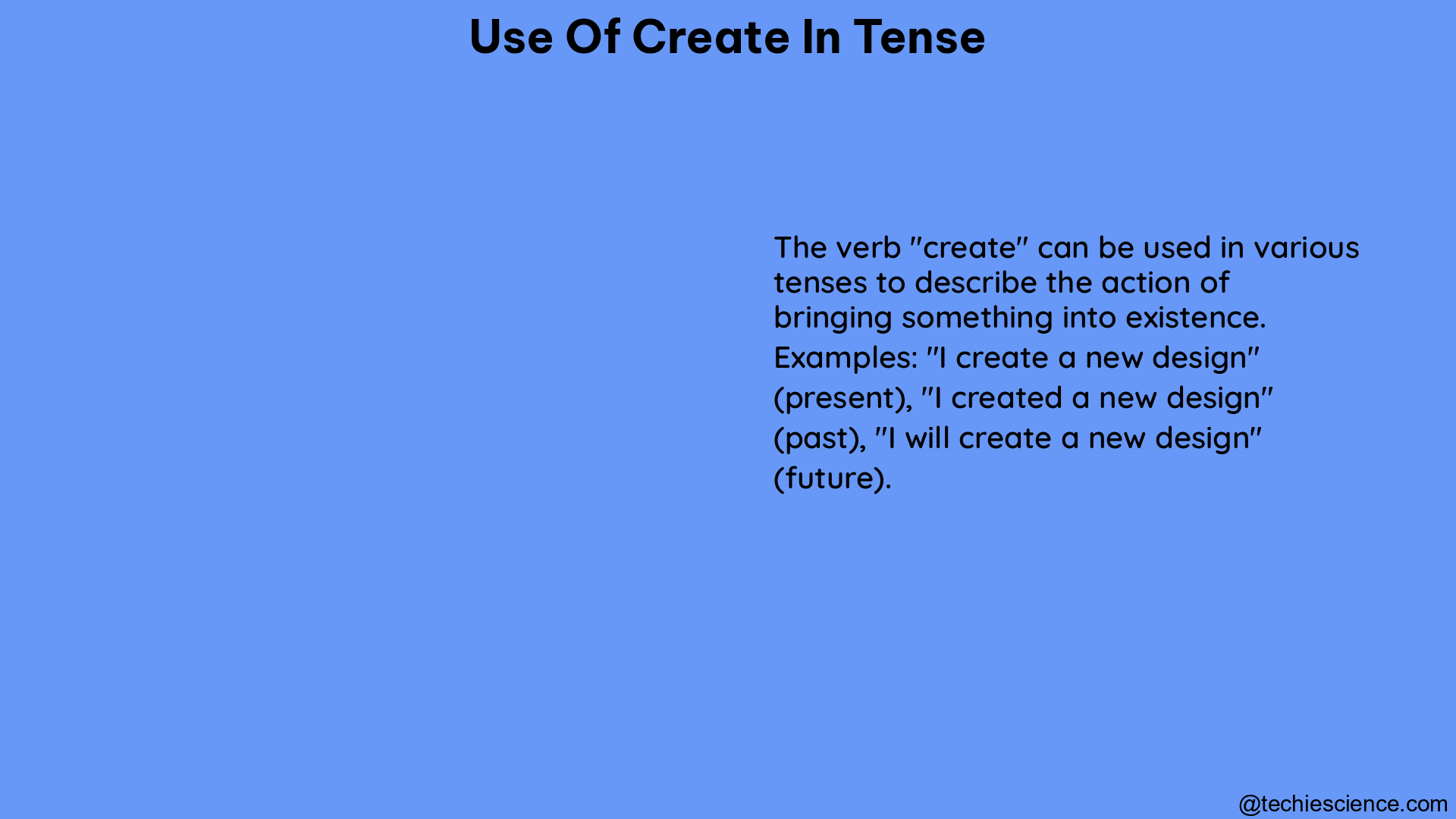The use of the verb “create” in various tenses is a crucial aspect of English grammar that can be challenging for both native and non-native speakers. This comprehensive guide will delve into the intricate details of using “create” in the infinitive, present, past, and future tenses, providing you with a thorough understanding of its grammatical specifications and practical examples.
Infinitive Form
The infinitive form of the verb “create” is “to create.” This form is used to express the action of creating in a general, non-specific way. Examples:
- She always strives to create beautiful paintings in her spare time.
- He enjoys the process of creating a new playlist for his morning run every week.
Present Tense

Present Simple
The present simple form of “create” is “create.” This form is used to express habitual or general actions. Examples:
- She creates two new designs every day for her fashion line.
- This renowned artist creates incredible works that captivate audiences.
Present Continuous
The present continuous form of “create” is “is creating.” This form is used to express an ongoing action happening at the moment of speaking. Examples:
- She is creating a new painting for the upcoming art exhibition.
- The team is creating its next app version, which is scheduled for release next month.
Present Perfect
The present perfect form of “create” is “has created.” This form is used to express an action that has been completed in the past, with a connection to the present. Examples:
- She has created a new recipe for the baking contest and won first prize.
- The team has created a working prototype of their new invention, which they are excited to showcase.
Present Perfect Continuous
The present perfect continuous form of “create” is “has been creating.” This form is used to express an ongoing action that began in the past and is still continuing in the present. Examples:
- She has been creating a new series of paintings for her upcoming solo exhibition.
- The team has been creating its next app version for months, incorporating user feedback along the way.
Past Tense
Past Simple
The past simple form of “create” is “created.” This form is used to express a completed action in the past. Examples:
- They created a beautiful mural on the side of the old warehouse last summer.
- She created a new recipe for the baking contest and won first prize.
Past Continuous
The past continuous form of “create” is “was creating.” This form is used to express an ongoing action in the past. Examples:
- She was creating a new painting when the phone rang, interrupting her flow.
- The team was creating its next app version last month, working tirelessly to meet the deadline.
Past Perfect
The past perfect form of “create” is “had created.” This form is used to express an action that was completed before another past action or a specific point in time. Examples:
- She had created a new recipe for the baking contest before she entered the competition.
- The team had created a working prototype of their new invention by the time the deadline arrived.
Past Perfect Continuous
The past perfect continuous form of “create” is “had been creating.” This form is used to express an ongoing action that was in progress before another past action or a specific point in time. Examples:
- She had been creating a new series of paintings for months before the exhibition opened.
- The team had been creating its next app version for months before the launch date.
Future Tense
Future Simple
The future simple form of “create” is “will create.” This form is used to express a future action. Examples:
- She will create a new painting for the upcoming art exhibition.
- The team will create its next app version next year, incorporating the latest technology.
Future Continuous
The future continuous form of “create” is “will be creating.” This form is used to express an ongoing action in the future. Examples:
- She will be creating a new painting when the art exhibition starts next month.
- The team will be creating its next app version next month, working diligently to meet the release deadline.
Future Perfect
The future perfect form of “create” is “will have created.” This form is used to express an action that will be completed before a specific point in the future. Examples:
- She will have created a new recipe for the baking contest by next week, giving her time to practice.
- The team will have created a working prototype of their new invention by the time the deadline arrives.
Future Perfect Continuous
The future perfect continuous form of “create” is “will have been creating.” This form is used to express an ongoing action that will be in progress before a specific point in the future. Examples:
- She will have been creating a new series of paintings for months by the time the exhibition starts.
- The team will have been creating its next app version for months by the time it is launched, ensuring a polished final product.
Common Mistakes
Two common mistakes to be aware of when using “create” in different tenses are:
-
Confusing Forms: Using the base form “create” instead of the past participle “created” in perfect tenses, such as “She has create a new recipe” instead of “She has created a new recipe.”
-
Misusing Past Simple: Using the past simple form “created” instead of the past participle in passive constructions, such as “The mural was created last summer” instead of “The mural was created last summer.”
By understanding the proper usage of “create” in various tenses and avoiding these common mistakes, you can effectively communicate your ideas and demonstrate a strong command of English grammar.
References
- https://en.bab.la/conjugation/english/create
- https://www.wordreference.com/conj/enverbs.aspx?v=create
- https://promova.com/past-tense-of/create
- https://grammarbrain.com/past-tenses/past-tense-of-create-conjugations-in-past-and-present-participles/
- https://ell.stackexchange.com/questions/89604/was-created-vs-has-been-created

Hi…. I am Goutam Datta. I have completed a double M. A. in English and B. Ed. I am a creative writer. Currently, I am a part of the LambdaGeeks.